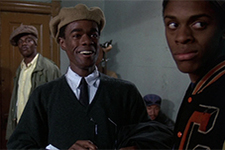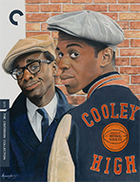Cooley High
|  In Black Directors in Hollywood, Melvin Donalson gives one of the book's eleven chapters entirely to Michael Schultz, whom he dubs “The Crossover King” (the only other director to get his own chapter is Spike Lee). One needn’t look at Donalson’s book, however, to recognize Schultz’s importance in giving black cinema an expanded place in Hollywood, particularly in the 1970s and ’80s. Along with Gordon Parks’s The Learning Tree (1969), Schultz’s early films were rare examples of black films that weren’t easily categorized (or marginalized) as blaxploitation. Rather, Schultz showed that he could make films that spoke honestly and directly about the experience of being black in America, but in a way that cut across racial divides and spoke to a larger experience. Chief among those films is Cooley High, which was clearly made as a black version of George Lucas’s breakout independent hit American Graffiti (1973), which successfully captured the nostalgia of an earlier age amid the tumult of the Vietnam era with both bawdy humor and dramatic poignancy. The script for Cooley High was written by Eric Monte from a month of recorded discussions he had with Schultz about his own experiences growing up in and around the notorious Cabrini-Green Housing project in Chicago, where the film is largely set (as was the television series Good Times, which Monte had co-created with actor Mike Evans in 1974 for All in the Family producer Norman Lear). And, while Cooley High does not shy away from the harsh realities of growing up poor and black in the inner city in the early 1960s, it does not wallow in victimhood, either, showing how its characters lead determined, vibrant lives that, while certainly inflicted by poverty and its attendant social problems, including drugs and gangs, are not entirely defined by it. The differences between Cooley High’s characters and American Graffiti’s are clearly drawn along racial and socioeconomic lines, but the fundamental essence of the stories and the importance they place on the indeterminate zone navigated by high school seniors as they prepare to leave behind adolescence and fully enter the adult world,is the same (as is the strong reliance on a back catalog of immediately recognizable pop tunes, in this case Motown hits by the Supremes, Martha Reeves & the Vandellas, Stevie Wonder, the Four Tops, and others). Cooley High’s central characters are two best friends: Leroy “Preach” Jackson (Glynn Truman) and Richard “Cochise” Morris (Lawrence Hilton-Jacobs). Like many best friends, Preach and Cochise are demonstrably different: Preach, who is bespectacled and small in stature, has a brash and loud exterior that masks his internal insecurities and desire to be a poet, while Cochise is a gifted athlete who is as successful with girls as Preach wishes he could be. They both have dreams—Preach to go to Hollywood to be a screenwriter and Cochise to play professional basketball—that define them against the failures of their world, which is omnipresent in the trashed-out vacant lots, imposing government housing and its claustrophobic hallways, and graffiti-strewn brick walls. The narrative follows Preach and Cochise and several of their friends as they go about the time-honored rituals of late adolescence: ditching school (they all attend Edwin G. Cooley Vocational High School), hitching free rides on the back of the bus, going to quarter parties, trying (and often failing) to “make out” with girls. Their carefree sensibility is potentially dangerous in numerous ways, as Preach is at risk of failing school despite his clear intelligence, Cochise needs to score an athletic scholarship in order to go to college, and their decision to engage in some illegal activities like joyriding in a stolen car with a pair of dangerous schoolmates puts them in real jeopardy. The film offers a voice of reason in the form of Mr. Mason (Garrett Morris), a no-nonsense teacher who cuts them no slack while also recognizing and encouraging their potential. Throughout Cooley High, Schultz balances the demands of raucous comedy with more introspective drama, and for the most part it works well. There are a few parts that feel a bit mean-spirited, including a scene where Preach and Cochise con a pair of clearly desperate prostitutes out of money by pretending to be undercover cops, but most of it is in good fun. We get the requisite fights, make-out sessions, and scenes of best friends razzing each other relentlessly, but there are also quiet scenes involving Preach’s growing romance with Brenda (Cynthia Davis), who initially sees him as boorish and rude until she learns about his love of poetry, and one moving scene in which Preach’s mother, who works three jobs to keep him and his siblings with a home and food, falls asleep at the table from sheer exhaustion after asking him to get her belt so she can punish him for getting arrested. Tragedy is always lurking around the corner, and the humor often distracts us from the darker realities of the characters’ world, but it can’t hold out forever. When Schultz directed Cooley High, he had already found significant success on the stage, where he directed both off-Broadway and Broadway productions. His initial forays behind the camera were made-for-television adaptations of plays, including Lorraine Hansberry’s To Be Young, Black, and Gifted, which Schultz shot for PBS in 1970 using 16mm film, rather than video. He had also directed two small, independent films: Together for Days (1970) about a radical black activist and the blaxploitation-style adventure film Honey Baby Honey Baby (1974). Cooley High was something altogether different, and it proved to be a major box office hit, which gave Schultz the clout to continue working and make films like Car Wash (1976), an Altmanesque look at the day in the life of more than two dozen characters who work at a car wash, the Richard Pryor comedies Greased Lightning (1977) and Which Way Is Up? (1977), and Carbon Copy (1985), which gave Denzel Washington one of his first major screen roles. Schultz never stopped working in television, and after a number of disappointing features in the 1980s, he moved almost exclusively into that realm, directing hundreds of television episodes and made-for-television movies. The fact that he never quite made good on the promise he showed in the mid-’70s is disappointing, but one can’t fault him for being so prolific and leaving his imprint on so many areas—stage and screens, large and small. Cooley High, though, will remain one of his most significant contributions, a film that changed the way many people thought of “black films.”
Copyright © 2023 James Kendrick Thoughts? E-mail James Kendrick All images copyright © The Criterion Collection | |||||||||||||||||||||||||||||
Overall Rating: 


 (3.5)
(3.5)


